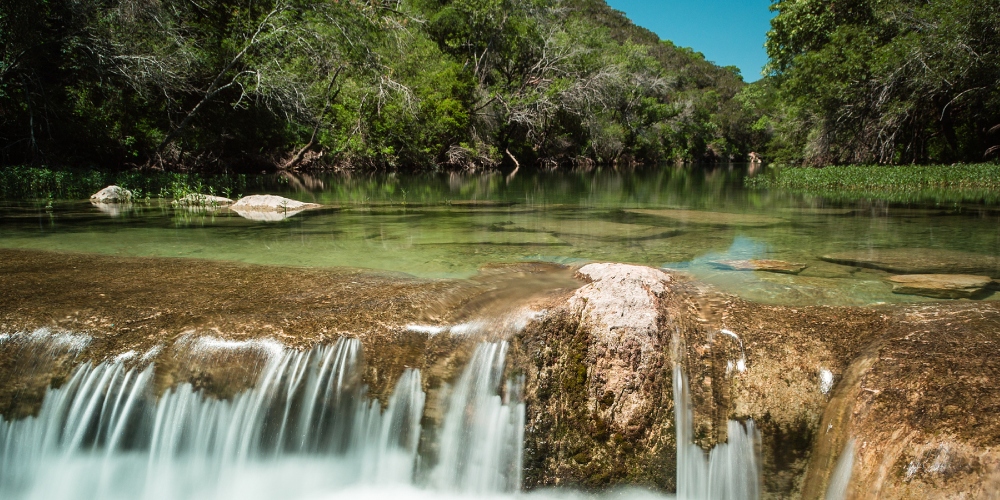When looming development threatened an idyllic slice of the Texas Hill Country known as the Pedernales Falls River Corridor, a group of like-minded neighbors took action to preserve the rare riverside beauty, habitat and history of the corridor, not only for themselves, but for future generations.
These landowners used conservation easements to protect their property forever, and are encouraging other property owners along the corridor to do so as well.
Out in the Texas Hill Country, a quiet movement is afoot. Almost literally underfoot, as it centers around land – one rare and beautiful stretch of land offering a sensory feast, archaeological insights, drinking water for tens of thousands of people, and a place for an endangered little species of bird to call home.
“The Pedernales Falls River Corridor, while relatively close to both Austin and San Antonio, is fairly untouched by development,” notes Beyrl Armstrong, a naturalist and consultant with Plateau Land & Wildlife. “You can float the river
between Pedernales Falls State Park and Reimer’s Ranch Park [about 30 miles], and see just a few houses along the way. Its value in terms of scenic beauty, natural habitat, and water quality, clarity and availability is, I believe, unmatched in our state.”
This informal movement to ensure the preservation of the ecologically, geographically and historically unique Pedernales Falls River Corridor is being led by concerned private landowners – some of whom are doing their part by securing conservation easements for their corridor properties – assisted by land-conservation professionals. A conservation easement is a contract between a landowner and a land trust – typically a nonprofit conservation organization – where the landowner outlines exactly how the land can or cannot be used, in order to protect its natural or other special features. The landowner retains legal title to the property, but donates or sells the development rights to the land trust. In turn, the land trust ensures the restrictions on the property are followed in perpetuity.
Mike and Pam Reese purchased their first tract of land along the Pedernales – just over 700 acres – in 1995. A couple of years later, the landowner across the river decided to break up her property into 25 – 30-acre fragments and sell them. The Reeses, troubled by the development, bought up all of the neighbor’s acreage, so that today the Reeses’ land totals about 2,200 acres, including more than three miles of river frontage. The purchase marked the start of the Reeses’ passion for preserving the Pedernales Falls River Corridor.
“The Reeses are stellar landowners,” confirms Dan Snodgrass, director of the Pedernales River Project for The Nature Conservancy, a leading ecological conservation organization. “They exemplify the type of land stewardship we love to see and work with.”
When the Reeses decided they wanted to protect their land with a conservation easement – “We don’t want it to become a development, even when we’re gone,” says Mike – they chose The Nature Conservancy as their land trust. And they selected Thomas Hall, a conservation attorney with Braun & Gresham, to guide them through the process.
“Braun was the natural go-to firm to do the conservation easement,” Mike says. “Thomas was extremely informed and helpful. It is a complex process, because everything you do is a done deal forever. We didn’t realize all the things you need to consider, and Thomas brought up many things we’d never thought of.
“Easements are a large step in protecting the land,” Mike Maples affirms, “All of our neighbors need to consider and decide for themselves what an easement would mean for them, but I strongly recommend it.”
It took almost a year and lots of discussion between us, the attorneys and the Conservancy to really nail down this contract.” “The Conservancy views a conservation easement as a marriage of sorts with the landowner,” explains Snodgrass. “The process is part education – as we help the landowner understand how the agreement works – and part negotiation – as we work together to understand each others’ interests.”
The Reeses, delighted with their own conservation-easement experience, have become devoted and active advocates.
“We’re doing what we can to promote this kind of conservation for the future,” Pam affirms. “We’ve purchased two other ranches close-by to save them from planned development. On one of them, we partnered with Matt and Peggy Winkler, and they also worked with the Braun law firm and The Nature Conservancy to put their land under a conservation easement. And we’re searching for conservation-minded landowners to sell our two other tracts to.”
Corridor neighbors Mike and Carolyn Maples have opted for conservation easements as well, but approached the decision from a slightly different angle.
“To me, a conservation easement is a financial transaction,” states Mike Maples. “I always thought we would probably do it, to protect the land and keep it as a singular property. But I wanted to make sure the timing was right, so we could optimize the benefits of it.”
Conservation easements can carry considerable costs – from attorney’s fees to an endowment for the land trust to fund its perpetual administration of the agreement. But they can also offer significant tax benefits. The donation of a conservation easement is considered a charitable contribution and is deductible from federal income taxes, which can produce substantial savings. And restricting development lowers the overall market value of the land, which can lower federal estate taxes and property taxes for the landowner.
The Maples worked with Braun & Gresham’s Hall not only to maximize their immediate tax benefits, but also to minimize their children’s future tax liabilities regarding the land. Hall suggested putting the land into conservation easement in three phases, so that the Maples and their heirs might realize tax benefits over a longer period of time.
“Currently, we’ve got about one-third of the property – about 450 of almost 1,500 acres – under a conservation easement,” Maples elaborates. “We chose the eastern third because it had no structures or anything at all on it, so the easement was very clean and very easy to create. It was completed within about two months.”
The Maples’ property – and easement – not only lets them carefully manage a game program of exotic deer and antelope, but also features archeological signs of the land’s human habitation for about the past ten thousand years: undisturbed American Indian mounds; several caves, one with documented and verified Indian pictographs; and the reputed locale of the last battle between the Texas Rangers and the Comanche tribe, as well as extraordinary water abundance in several spring-fed ponds and deep wells.
Other private lands close to the river feature four rare natural collapsed grotto features – a waterfall flowing into a 30-foot- deep, 200-feet around pool of water surrounded by a cave. Additionally, the Pedernales Falls River Corridor hosts a significant population of the endangered Golden-Cheeked Warbler. The bird breeds exclusively in Texas, and the corridor includes some of the last of the closed-canopy woodland necessary for their nurseries. The endangered Black-Capped Vireo calls the corridor home, too.
The Maples intend to place the rest of their ranch under a conservation easement with Texas Land Conservancy (TLC), one of the state’s oldest and largest land trusts. TLC also worked with Dan Jessee – another corridor neighbor with land directly on the banks of the Pedernales River, and a client of Hall’s – on his easement donation.
“The Pedernales is getting so much pressure from development coming out of Austin,” says TLC executive director Mark Steinbach. “Our goal is to slow down development, connect with the landowners along the corridor, and create big blocks of protected, ecologically beneficial habitat.”
“In Texas, the initiative of private landowners is the key to protecting the river,” agrees Hall. “This generation is planting the tree, but the shade will benefit many generations to come.”
This movement, albeit patchworked, is progressing. Now, these landowners feel the time has come for state leaders to step in and step up to ensure the corridor’s permanent preservation.
“With our community of like-minded landowners, we have a great deal of the corridor protection done,” Armstrong asserts. “Now we must bring the properties key to completing it into the fold. The best way to do that is [for the state] to purchase easements on them. Judiciously buying easements from willing sellers at reasonable prices is an opportunity that will not come again, and that would be a tremendous service for the state of Texas and its people.”
Meanwhile, riverside residents like the Reeses, Winklers, and Maples continue to spread the good word about their own conservation easement experiences.
“Easements are a large step in protecting the land,” Mike Maples affirms. “All of our neighbors need to consider and decide for themselves what an easement would mean for them, but I strongly recommend it.”
“It requires serious thought and commitment,” concurs Pam Reese. “But it’s given us great satisfaction to know we’ve contributed to keeping this part of the Hill Country the way it is now. Maybe someday, somebody will love our ranch the way we do. I hope so.”



